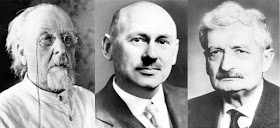 |
| Who Invented the Rocket? Konstantin Tsiolkovsky, Robert Goddard, Hermann Oberth |
In 1903, Konstantin Tsiolkovsky published a seminal work, The Exploration of Cosmic Space by Means of Reaction Devices. In the volume, he calculated the speed required to send an object into a minimal orbit around the Earth. He also described how this feat could be achieved using a multi-stage rocket fueled with liquid oxygen and liquid hydrogen.
Tsiolkovsky worked out many of the details associated with rocketry and space travel. He conceived of fuel pump systems, space stations, rockets with steering thrusters, airlocks for spacewalks, optimal trajectories for returning spacecraft, and close-loop life support systems.
However, Tsiolkovsky was a theorist who was ahead of his time. The practical work of putting his theories into practice was done by others. One of them was an American professor named Robert Goddard, who proved adept at both the theoretical and practical sides of rocketry.
Goddard invented the first modern rocket. On the cold day of March 16, 1926, Goddard launched a liquid-fueled rocket for the first time in Auburn, Massachusetts. The rocket, which he named Nell, rose to an altitude of 41 feet in 2.5 seconds before crashing into a cabbage field.
Over the 15 years that followed, Goddard and his team launched a total of 34 rockets, reaching speeds of 550 miles per hour and altitudes of 1.6 miles. Goddard also developed three-axis control, gyroscopes, and steerable thrust systems to control rockets in flight. He secured 214 patents, including designs for multi-stage and liquid-fuel rockets. In 1919, Goddard published a book, A Method of Reaching Extreme Altitudes, which became a classic text in rocketry.
Stung by the press for criticism of his pioneering work, Goddard became very private in his later years. Thus, he didn’t get nearly as much credit for his achievements during his lifetime. Only years after he died in 1945 was Goddard recognized as one of the fathers of modern rocketry.
During the same period that Goddard was launching his rockets, an Austro-Hungarian physicist named Hermann Oberth was becoming a well-known rocket expert in Europe. In 1923, he published an influential book, By Rocket into Interplanetary Space, laying out how rockets could fly in space. Six years later, he expanded upon that text with a sequel, Ways to Spaceflight.
In 1928, a copy of By Rocket into Interplanetary Space found its way into the hands of a 16-year-old Prussian aristocrat named Wernher von Braun. The young student had always been interested in space, and here was a practical guide on how to get there.
Oberth would become a mentor to von Braun. Both became active members in the Society for Space Travel, an amateur group that conducted rocket launches outside of Berlin in the early 1930s. The society later folded, and von Braun would go on to lead the German Army rocket team that launched the first ballistic missile, the V-2, in 1942. By that time, Oberth was working for von Braun, his former student.
No comments:
Post a Comment
IT'S YOUR TURN...
To respond : Drop in just anything but spam. Please don't drop comments just to add your link here. You can use basic HTML tags.
Important : If you're looking for further clarification, advice or support, please address by comment.